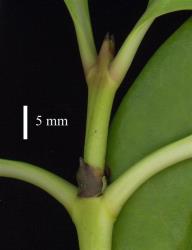- Taxon
- Gallery
Small tree to c. 6(-9) m tall and 10(-25) cm dbh, sometimes shrubby; outer bark thin, at first smooth and cream-coloured, becoming grey-brown and flaky-tessellated, only weakly brown-orange at inside against the underbark; twigs glabrous, maturing to have a shiny mid-brown periderm. Leaf blades glabrous but sometimes at first with minute hairs on distal margins, 4.5-9 (-14) × 3-5.5(-10) cm, (broad-)ovate, chartaceous, mid-green in life, base shortly attenuate, apex subobtuse with a short broad acumen, margin of mature leaves in distal half obscurely sinuous to regularly curved, not at all crenate nor with minute irregular outgrowths or scabridities; venation conspicuous on both surfaces, sunken above, the tertiary and lesser veins closely reticulate and, as seen on lower surface, commonly approaching closer than 2 mm to the midrib; pit-domatia to c. 1.5 mm diam. or more present in the axils of the secondary veins below; petiole to c. 1(-1.8) cm long. Stipules c. 4-7 mm long, membranous, triangular in face view, sheathing for c. ½ length, face slightly keeled and tipped by a single broadly conical gland-denticle c. 1 mm long; stipule soon drying and abscising. Inflorescences on the proximal nodes of the newest shoot flushes, also a few on adjacent bare parts of stems, axillary, sometimes two per axil (upper one the larger). Flowers sessile, basically in triads with the central flower dominant but this arrangement often obscured by congestion and incomplete development and the flowers then appearing to be in fascicles; bracts between the triad members c. 1-2 mm long, flattened to triangular, glandular-denticulate. Male inflorescence: peduncle (first internode) 1-2 cm long, 2 mm wide, flattened, usually somewhat decurved distally; first node with a pair of stipulate reduced leaves, and usually three short internodes above, the two lateral ones each terminated by a fascicle of c. 5 flowers and the central internode by a fascicle of c. 7-15 flowers, the inflorescence ultimately appearing as a pedunculate group of (1-)3 fascicles, each sur-mounting a short axis; calyx a dentate rim c. 0.5 mm tall, usually with a few obscure cilia; coroIia in mature bud 9 mm long, 2.5 mm diam., lobed to c. halfway, lobes usually 5; anthers 6.5 mm long. Female inflorescence: peduncle 0.5-2(-3) cm long, 2.5 mm wide, flattened, 2 mm wide, straight (in life held ± erect or antrorsely curved); first node with a pair of stipulate reduced leaves and a triad of flowers (rarely a single flower) or, more usually, a pair of axillary flowers and a second internode c. 1 cm long terminated by a 3(-7)-flowered fascicle; calyx as in male flower; corolla in mature bud c. 8 mm long, 1.5 mm diam., 4-5-lobed to c. halfway; stigmas 15 mm long. Drupe 5-10 × 4-8 mm, broad-oblong, maturing with both skin and flesh yellowish to orange and with a ring of dark vinous coloration in the calyx and close around its base, calyx to 1(-2) mm tall, usually lobed to c. halfway. Pyrenes 5-6.5(-7.5) × 3-4 mm, oblong, dirty white, dorsally with a pair of obscure lateral ridges (and rarely an obscure median ridge), transverse ridging weak or often lacking, the operculum 2/5 as long as pyrene.
[Reproduced from Gardner & Heads (2003, New Zealand J. Bot. 28: 67-80) with permission from The Royal Society of New Zealand.]




